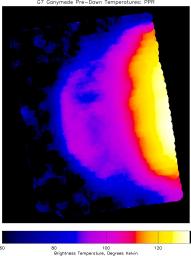
|
Pre-Dawn Temperatures on Ganymede
- Click the image above for a larger view
- Full-Res JPEG (988 x 1330) (81.3 kB)
- Full-Res TIFF (988 x 1330) (1.7 MB)
Caption:
This infrared image of Jupiter's moon Ganymede, showing heat radiation from its surface at a wavelength of 27 microns (millionths of a meter), provides the best view yet of pre-dawn temperatures on Ganymede. Temperatures, derived from the brightness of the infrared radiation, can be determined from the colors by reference to the scale at the bottom of the image.
The image, taken by NASA's Galileo spacecraft, shows half of Ganymede's disk as seen by the approaching spacecraft. Longitudes covered range from 340 on the right of the image, through longitude zero (the direction facing Jupiter) to longitude 60 near Ganymede's limb on the left. The morning terminator, near longitude 15, curves through the middle of the image, separating areas experiencing the last hours of the long (3.5 Earth day) Ganymede night, on the left, from areas that are warming up in the morning sunshine, on the right. Ganymede's north pole is in the upper right corner of the image, and the south pole is in the lower right. Ganymede rotates from left to right.
Nighttime temperatures, shown in blue and purple colors, are in the range 85 - 100 Kelvin (-306 to -279 F). The surface cools steadily during the night, so the warmest nighttime temperatures are on the left side of the disk, and temperatures drop towards the dawn terminator on the right, before warming rapidly once the sun rises (the red, yellow and white areas on the far right). Study of the rate of nighttime cooling and the rate of post-sunrise warming, will provide information about Ganymede's surface properties.
The image was taken with Galileo's PPR (Photopolarimeter-Radiometer) instrument on the spacecraft's seventh orbit around Jupiter, from a range of about 190,000 kilometers (118,060 miles). Surface temperatures derived from the strength of infrared radiation, as was done here, are called "brightness temperatures," and may be slightly in error.
The PPR instrument builds up an image by slowly scanning across the target over a period of up to one hour. The motion of Galileo relative to Ganymede during this time causes distortions in the satellite shape on the image, which therefore appears slightly non-circular. The small overlapping circles that make up the image show the size of the area, about 450 kilometers (280 miles) across, covered by each individual PPR measurement. Blue spots in the dark sky in the left-hand portion of the image are due to noise.
Background Info:
JPL manages the Galileo mission for NASA's Office of Space Science, Washington, D.C.
Cataloging Keywords:
| Name | Value | Additional Values |
|---|---|---|
| Target | Ganymede | Jupiter |
| System | Jupiter | |
| Target Type | Satellite | Planet |
| Mission | Galileo | |
| Instrument Host | Galileo Orbiter | |
| Host Type | Orbiter | |
| Instrument | Photopolarimeter-Radiometer (PPR) | |
| Detector | ||
| Extra Keywords | Color, Infrared, Rotation | |
| Acquisition Date | ||
| Release Date | 1998-01-21 | |
| Date in Caption | ||
| Image Credit | NASA/JPL/Lowell Observatory | |
| Source | photojournal.jpl.nasa.gov/catalog/PIA01145 | |
| Identifier | PIA01145 | |
